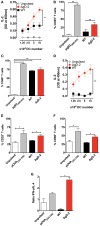US6 Gene Deletion in Herpes Simplex Virus Type 2 Enhances Dendritic Cell Function and T Cell Activation
- PMID: 29176979
- PMCID: PMC5686121
- DOI: 10.3389/fimmu.2017.01523
US6 Gene Deletion in Herpes Simplex Virus Type 2 Enhances Dendritic Cell Function and T Cell Activation
Abstract
Herpes simplex virus (HSV) type 1 (HSV-1) and type 2 (HSV-2) produce lifelong infections that are associated with frequent asymptomatic or clinically apparent reactivation. Importantly, HSV express multiple virulence factors that negatively modulate innate and adaptive immune components. Notably, HSV interfere with dendritic cell (DC) viability and function, likely hindering the capacity of the host to mount effective immunity against these viruses. Recently, an HSV-2 virus that was deleted in glycoprotein D was engineered (designated ΔgD-2). The virus is propagated on a complementing cell line that expresses HSV-1 gD, which permits a single round of viral replication. ΔgD-2 is safe, immunogenic, and provided complete protection against vaginal or skin challenges with HSV-1 and HSV-2 in murine models. Here, we sought to assess the interaction of ΔgD-2 with DCs and found that, in contrast to wild-type (WT) virus which induces DC apoptosis, ΔgD-2 promoted their migration and capacity to activate naïve CD8+ and CD4+ T cells in vitro and in vivo. Furthermore, DCs exposed to the WT and ΔgD-2 virus experienced different unfolded protein responses. Mice primed with DCs infected with ΔgD-2 in vitro displayed significantly reduced infection and pathology after genital challenge with virulent HSV-2 compared to non-primed mice, suggesting that DCs play a role in the immune response to the vaccine strain.
Keywords: HSV type 2; adaptive immunity; apoptosis; dendritic cells; glycoprotein D; migration; unfolded protein response.
Figures








Similar articles
-
Pharmacological Inhibition of IRE-1 Alpha Activity in Herpes Simplex Virus Type 1 and Type 2-Infected Dendritic Cells Enhances T Cell Activation.Front Immunol. 2022 Jan 5;12:764861. doi: 10.3389/fimmu.2021.764861. eCollection 2021. Front Immunol. 2022. PMID: 35069537 Free PMC article.
-
A Herpes Simplex Virus Type 2 Deleted for Glycoprotein D Enables Dendritic Cells to Activate CD4+ and CD8+ T Cells.Front Immunol. 2017 Aug 9;8:904. doi: 10.3389/fimmu.2017.00904. eCollection 2017. Front Immunol. 2017. PMID: 28848543 Free PMC article.
-
Protective immunity to genital herpes simplex virus type 1 and type 2 provided by self-adjuvanting lipopeptides that drive dendritic cell maturation and elicit a polarized Th1 immune response.Viral Immunol. 2006 Summer;19(2):220-36. doi: 10.1089/vim.2006.19.220. Viral Immunol. 2006. PMID: 16817765
-
Prophylactic and therapeutic modulation of innate and adaptive immunity against mucosal infection of herpes simplex virus.Immune Netw. 2014 Aug;14(4):187-200. doi: 10.4110/in.2014.14.4.187. Epub 2014 Aug 22. Immune Netw. 2014. PMID: 25177251 Free PMC article. Review.
-
Herpes simplex virus interference with immunity: Focus on dendritic cells.Virulence. 2021 Dec;12(1):2583-2607. doi: 10.1080/21505594.2021.1980990. Virulence. 2021. PMID: 34895058 Free PMC article. Review.
Cited by
-
Immune Response to Herpes Simplex Virus Infection and Vaccine Development.Vaccines (Basel). 2020 Jun 12;8(2):302. doi: 10.3390/vaccines8020302. Vaccines (Basel). 2020. PMID: 32545507 Free PMC article. Review.
-
Anti-herpetic Activity of Macrocystis pyrifera and Durvillaea antarctica Algae Extracts Against HSV-1 and HSV-2.Front Microbiol. 2020 Sep 11;11:2006. doi: 10.3389/fmicb.2020.02006. eCollection 2020. Front Microbiol. 2020. PMID: 33013743 Free PMC article.
-
Pharmacological Inhibition of IRE-1 Alpha Activity in Herpes Simplex Virus Type 1 and Type 2-Infected Dendritic Cells Enhances T Cell Activation.Front Immunol. 2022 Jan 5;12:764861. doi: 10.3389/fimmu.2021.764861. eCollection 2021. Front Immunol. 2022. PMID: 35069537 Free PMC article.
-
Endoplasmic Reticulum-Associated Degradation-Dependent Processing in Cross-Presentation and Its Potential for Dendritic Cell Vaccinations: A Review.Pharmaceutics. 2020 Feb 13;12(2):153. doi: 10.3390/pharmaceutics12020153. Pharmaceutics. 2020. PMID: 32070016 Free PMC article. Review.
-
The Chinese Herbal Prescription JieZe-1 Inhibits Membrane Fusion and the Toll-like Receptor Signaling Pathway in a Genital Herpes Mouse Model.Front Pharmacol. 2021 Sep 24;12:707695. doi: 10.3389/fphar.2021.707695. eCollection 2021. Front Pharmacol. 2021. PMID: 34630083 Free PMC article.
References
Grants and funding
LinkOut - more resources
Full Text Sources
Other Literature Sources
Research Materials

